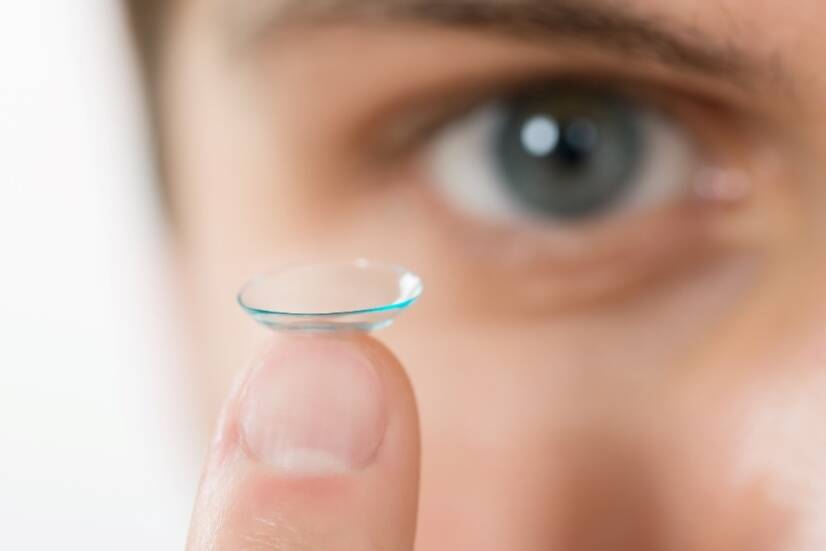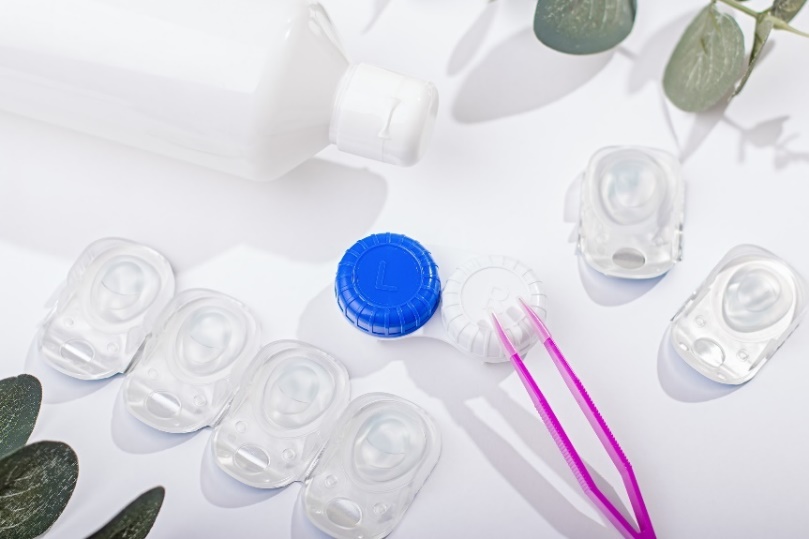- news-medical.net - Everything you need to know about contact lenses. Medical news. Kate Anderton, B.Sc.
- solen.com - Cleaning systems in contact lens care - how to recommend the right cleaning solution at the pharmacy and how to educate the customer on proper use. Solen contact lenses. Veronika Bucharova
- theses.cz - Selected types of special contact lenses. Faculty of Science, Palacký University in Olomouc, Department of Optics. Bachelor thesis. Katarína Varhaníková
- ŠTROFOVÁ, Helena. Practical Ophthalmology. Prague.
Contact lenses and types. How to choose and care for them?

Contact lenses are commonly used in ophthalmology. They are a solution for various dioptric and cosmetic eye defects. However, several parameters need to be taken into account when choosing them. How to choose the right contact lenses? What types of lenses are there?
Article content
Contact lenses, their types, selection and care. Also information about diopters and cylinders or their sizes.
Contact lenses are an optical aid for various eye defects, but most often for myopia. Their biggest advantage over glasses is that they do not restrict the patient in various activities.
The correct choice of lens and the observance of certain hygiene rules are necessary. Types and kinds of lenses, care, parameters, contraindications and many other interesting information can be found in the article.
Categories and types of contact lenses
Unlike glasses, a contact lens is in direct contact with the eye. The advantage is practicality, but at the same time, wearing them entails certain hygiene principles. This applies to the use of all types of lenses in connection with various eye defects.
Thanks to the modern silicone hydrogel materials, their breathability and hydration, soft contact lenses are suitable for a wide range of customers with different eye defects. They can be classified according to the intended use, the material and especially the duration of use.
Hard contact lenses (GPL) are an alternative to soft contact lenses despite the absence of an aqueous component. Since the introduction of soft lenses, their use has declined significantly.
However, for some patients they are the only possible solution. They also have the advantage of being more durable and can be worn for longer periods of time. Hard, permeable lenses can be a solution for people with eye defects and irregularly shaped eyes.
Based on the purpose/objective of use, lenses are divided into:
- Corrective therapeutic
- Therapeutic
- Cosmetic
Corrective therapeutic lenses
Corrective contact lenses are the most commonly used type. They are used to correct and therefore correct refractive errors of the eye.
Myopia (nearsightedness ) - This is a lack of sharp distance vision. Dioptric lenses are marked to minus values. The shape of the eye is elongated and the image of vision is already formed in front of the retina.
Hyperopia (farsightedness ) - This is blurred, poor near vision. Diopters are marked with positive values. The shape of the eye is shorter and the image of vision is formed behind the retina.
Astigmatism - Blurred vision due to uneven curvature of the cornea of the eye. Lenses that correct this defect are called toric lenses. Toric lenses can correct both astigmatism and diopters at the same time.
Presbyopia (hyperopia) - A refractive error caused by aging of the eye and a decrease in its ability and speed to focus at near. Multifocal lenses are used.
Therapeutic lenses
The use of therapeutic lenses is common in today's ophthalmic practice beyond the correction of refractive errors.
They are an effective solution to a number of ocular disorders and corneal abnormalities. A common reason for their use is for mechanical protection and to aid healing after eye surgery, laser or corneal damage or transplantation.
Therapeutic contact lenses are designed for long-term wear.
Cosmetic lenses
These are used to correct abnormal conditions (e.g. irregular pupils), colour vision disorders or for cosmetic indications. They include coloured contact lenses to change the colour of the eye.
Nowadays, a combination of coloured and dioptric corrective lenses is possible.
Based on the period of use, lenses are divided into:
- Overnight
- Two-week
- Monthly
- Annual
One-day lenses
These are disposable lenses that are thrown away at the end of the day or after one use. They require less care in terms of hygiene because they are pre-packaged in special containers with a disposable solution.
However, clean hands when handling them are essential for hygiene and health.
They are suitable for casual wear, sportsmen, allergy sufferers and ordinary people. They are suitable for people with dry eye syndrome.
The advantage is that allergens and germs are less likely to settle on the surface of the lenses. Therefore, there is less risk of inflammation or infection.
Bi-weekly lenses
As the name suggests, these are lenses designed to last 14 days. At the end of each day, they are removed and placed in a special case with a special hydrating solution.
They are suitable for hygiene-conscious people and for those who want to reduce financial costs compared to daily disposable lenses.
Monthly lenses
They are worn repeatedly over the course of a month. At the end of the day, they are removed from the eye and placed back in the case with the solution. They are affordable and suitable for people with careful hygiene and care.
Annual lenses
Not so popular for refractive errors. Their disadvantage is the increased need for careful hygiene and care. They are suitable for people who are concerned about affordability.
The risk is the introduction of a pathogen into the eye.
Hygiene and care of lenses
As the lens is in direct contact with the surface of the eye, thorough hygiene and care is necessary.
The lens is a suitable environment for various microorganisms and bacteria that could threaten the health of the eye. If not properly cared for, there is a risk of inflammation and infection of the eye.
Thoroughly washed hands are essential when handling lenses (putting them in and out of the eye). Soap, warm water and a clean towel are essential.
Special lens removal equipment can also be used.
Care of the lens case is necessary and it should be cleaned and rinsed regularly. After one use, replace the old solution with a new one.
Do not wear them continuously at home if you do not have to. Definitely do not go to bed with your lenses. Apart from compromising hygiene, there is a risk of damage, clogging and eye irritation.
Basic hygiene:
- When handling lenses, wash your hands with soap and warm water.
- Regular cleaning and rinsing of the case
- Replacing the new solution after one use
- Do not use the lenses for longer than the replacement period
- Throw away an infected lens if it becomes inflamed.
- Do not store lenses anywhere other than in the lens case

Contraindications to lens wear
Contraindications to the use of lenses are mainly chronic inflammation and infection of the eye, dry eye syndrome with impaired tear production, eye moles, glaucoma or anomalies in the position of the eye ball.
They are also prevented by the presence of eye pathology that makes it pointless to apply contact lenses.
Some contraindications to contact lens wear may be relative. If the contraindication is removed, the patient's condition and contact lens application can be reassessed by an ophthalmologist.
How to choose the right lenses? Diopter, cylinder and other parameters
If you want to start with contact lenses, a consultation with an ophthalmologist or optometrist is advisable.
The parameters of spectacles and contact lenses may differ. The prescription for spectacles does not include the parameter of curvature and diameter of the lenses.
In addition to assessing the condition of your eyes, your eye care professional will measure the appropriate parameters for contact lenses. He or she will teach you how to handle the lenses - how to put them in and take them out. He or she will also recommend the brand and type of lenses.
Although the parameters may seem complicated at first glance, the lens marking system is quite simple.
Dioptres: plus or minus
Myopia, impaired distance vision, has a diopter designation of minus values. Conversely, impaired near vision has a diopter designation of positive values.
Thus, the number 0 indicates sharp vision and the - and + signs indicate the size of the diopter.
The more diopters an individual needs, the worse his vision becomes.
Toric lenses and cylinder
For astigmatism (uneven curvature of the cornea), the cylinder parameter is given. Such lenses are called toric or cylindrical. The cylinder indicates the strength of the curvature and has a value increasing in steps of 0.25.
Lenses for astigmatism have a minus sign in front of the value.
An additional parameter of toric lenses is the axis indicating the angle of curvature of the eye. It is measured in degrees and is usually marked AXIS on the packaging. The axis is determined in the range 0° to 180°.
Lens curvature
The lens curvature indicates how closely the lens fits the surface of the eye. A lower curvature means the lens is more curved and fits the eye better. A higher curvature value means the lens is flatter.
Most often, this value is between 8.0 and 9.0.
On the packaging, this figure is usually abbreviated BC (from the word Base Curve).
Lens diameter
The diameter determines how much of the cornea a given lens will cover. The diameter of a lens is therefore related to its width and is given in millimetres - usually between 13 and 15 millimetres.
A small variation (0.1-0.2 mm) should not affect the quality of vision. Larger variations in the diameter parameter can lead to discomfort and possibly distorted vision. On the packaging, this figure is given under the abbreviation DIA (from the English word diameter).
Adding a lens
The addition of the lens, abbreviated ADD, is an additional parameter of multifocal contact lenses. In this case, the dioptre indicates the value needed to correct distance vision and the addition indicates the value for near vision.
Interesting resources
Related










